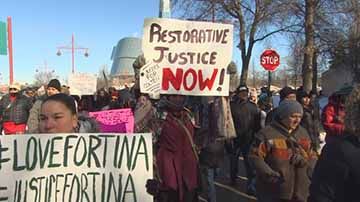Restorative justice at centre of Manitoba's new plan to keep people out of jail
Manitoba wants to divert more people away from jail, a new report on changes to the justice system says.

"This is about creating safer communities, it's about creating better access to justice, and that's what we're hoping to achieve out of this," Manitoba Justice Minister Heather Stefanson said Friday at the release of the Criminal Justice System Modernization Strategy report.
Manitoba has had the highest adult incarceration rate of all provinces for seven years in a row, Statistics Canada figures say.
"We have the highest incarceration rates in Canada, we have among the highest violent crime rates in Canada," Stefanson said.
"Clearly the status quo is not an option. This didn't happen overnight."
"The percentage of innocent people in our jails compared to those who are convicted and serving sentences is way too high," said John Hutton, executive director of the John Howard Society of Manitoba.
"I think we are at about 70 per cent in terms of remand custody and only 30 per cent of people serving a sentence."
The new strategy says fewer people should be held in remand.
"With appropriate community supports, many individuals can be released from custody pending their court hearing," it says.
It cites a recent Supreme Court of Canada decision that emphasizes granting bail to those accused of a crime. The province said it will follow that decision except in cases where the accused could jeopardize public safety.
The new strategy also relies heavily on diversion tactics such as restorative justice, which is a process where an offender takes responsibility for their actions, works to repair harm done to the victim or community, and takes steps to make positive life changes to stay out of the justice system.
In October 2017, the provincial government created the Restorative Justice Centre, which is housed in the John Howard Society building.
The strategy states the goal is "to improve outcomes for victims and offenders and reduce court backlog by removing certain matters from the courtroom."
Because so many of those incarcerated are Indigenous, Onashowewin Justice Circle executive director Julia Robson said she was happy to see the province taking more of a focus on restorative justice.
"We've been trying for years to get that message across and to say there's a better way of doing things," she said.
Responsible reintegration
Stefanson said the province is taking steps to reduce that backlog, including recent calls on the federal government to make changes to preliminary inquiries to help people move through the system more quickly.
"That's by no means where we're going to stop; we're going to continue to explore other ideas that people have out there to move us through the system more efficiently," she said.
Another strategy, the Responsible Reintegration Initiative, includes approaches aimed at reducing the backlog on the other end of the justice spectrum, tailored at helping people more effectively reintegrate into society upon release from jail or prison. More than 60 people have already participated in the program.
"We've had what we believe are some positive outcomes so far," said Stefanson, adding the province plans to bring more outgoing inmates through the initiative this year.
Identify funding, services
NDP MLA and justice critic Nahanni Fontaine said it would've been nice to see more specific details about funding and resources for community initiatives.
Hutton said while he is pleased to see a stronger focus on restorative justice, the province should take it a step further.
He said the process doesn't start until all parties are in agreement, so the accused often has to wait for access to services and supports.
"The restorative justice centre is in our building. They could identify services and supports accused individuals need right away, perhaps an anger management course, domestic violence course, something like that, and we offer them in the building," he said.
Four main objectives
The strategy was created in consultation with 21 partners, including the John Howard Society and nine Indigenous groups. Its four main objectives are:
• To reduce crime, improve community safety and reduce the number of individuals coming into conflict with the law and the criminal justice system.
• To deal with each case in a manner appropriate to the seriousness of the offence and the circumstances of the offender.
• To more effectively use restorative justice options to improve public safety, reduce delay in the court system and ultimately reduce reliance on incarceration, especially in the case of Indigenous offenders.
• To reintegrate offenders from custody to the community with essential supports to prevent further offences and future contact with the criminal justice system.
"They're music to my ears," said Hutton. "They make a lot of sense, they're workable, and they're long overdue, but I am pleased to see the government paying attention to them at this time."
Attention particularly needs to be paid to dealing with minor crimes like mischief, vandalism and shoplifting, he said.
"There's ways of dealing with those individuals in the community," he said. "We should not be incarcerating someone at the cost of $204 a day because they stole a chocolate bar."
Hutton wants the government to find a different way to deal with minor crimes, in turn freeing up more resources for more serious offences. He'd like the province to team up further with agencies like the John Howard Society to make that happen.
"We do see the size of the problem and we want to see the numbers of people incarcerated come down, we want to see the disproportionate representation of Indigenous people in custody come down, and we want to see the people reintegrating and not reoffending going forward," he said.
Jillian Taylor
CBC News
Mar 09, 2018